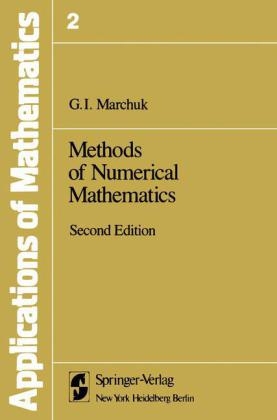
Methods of Numerical Mathematics
Springer-Verlag New York Inc.
978-0-387-90614-0 (ISBN)
- Titel ist leider vergriffen;
keine Neuauflage - Artikel merken
1 Fundamentals of the Theory of Difference Schemes.- 1.1. Basic Equations and Their Adjoints.- 1.1.1. Norm Estimates of Certain Matrices.- 1.1.2. Computing the Spectral Bounds of a Positive Matrix.- 1.1.3. Eigenvalues and Eigenfunctions of the Laplace Operator.- 1.1.4. Eigenvalues and Eigenvectors of the Finite-Difference Analog of the Laplace Operator.- 1.2. Approximation.- 1.3. Countable Stability.- 1.4. The Convergence Theorem.- 2 Methods of Constructing Difference Schemes for Differential Equations.- 2.1. Variational Methods in Mathematical Physics.- 2.1.1. Some Problems of Variational Calculation.- 2.1.1. The Ritz Method.- 2.1.3. The Galerkin Method.- 2.1.4. The Method of Least Squares.- 2.2. The Method of Integral Identities.- 2.2.1. Method of Constructing Difference Equations for Problems with Discontinuous Coefficients on the Basis of an Integral Identity.- 2.2.2. The Variational Form of an Integral Identity.- 2.3. Difference Schemes for Equations with Discontinuous Coefficients Based on Variational Principles.- 2.3.1. Simple Difference Equations for a Diffusion Based on the Ritz Method.- 2.3.2. Constructions of Simple Difference Schemes Based on the Galerkin (Finite Elements) Method.- 2.4. Principles for the Construction of Subspaces for the Solution of One-Dimensional Problems by Variational Methods.- 2.4.1. A General Approach to the Construction of Subspaces of Piecewise-Polynomial Functions.- 2.4.2. Constructing a Basis Using Trigonometric Functions and Applying It in Variational Methods.- 2.5. Variational-Difference Schemes for Two-Dimensional Equations of Elliptic Type.- 2.5.1. The Ritz Method.- 2.5.2. The Galerkin Method.- 2.5.3. Methods for Constructing Subspaces.- 2.6. Variational Methods for Multi-Dimensional Problems.- 2.6.1. Methods of Choosing the Subspaces.- 2.6.2. Coordinate-by-Coordinate Methods for Multi-Dimensional Problems.- 2.7. The Method of Fictive Domains.- 3 Interpolation of Net Functions.- 3.1. Interpolation of Functions of One Variable.- 3.1.1. Interpolation of Functions of One Variable by Cubic Splines.- 3.1.2. Piecewise-Cubic Interpolation with Smoothing.- 3.1.3. Smooth Construction.- 3.1.4. The Convergence of Spline Functions.- 3.2. Interpolation of Functions of Two or More Variables.- 3.3. An r-Smooth Approximation to a Function of Several Variables.- 3.4. Elements of the General Theory of Splines.- 4 Methods for Solving Stationary Problems of Mathematical Physics.- 4.1. General Concepts of Iteration Theory.- 4.2. Some Iterative Methods and Their Optimization.- 4.2.1. The Simplest Iteration Method.- 4.2.2. Convergence and Optimization of Stationary Iterative Methods.- 4.2.3. The Successive Over-Relaxation Method.- 4.2.4. The Chebyshev Iteration Method.- 4.2.5. Comparison of the Convergence Rates of Various Iteration Methods for a System of Finite-Difference Equations.- 4.3. Nonstationary Iteration Methods.- 4.3.1. Convergence Theorems.- 4.3.2. The Method of Minimizing the Residuals.- 4.3.3. The Conjugate Gradient Method.- 4.4. The Splitting-Up Method.- 4.4.1. The Commutative Case.- 4.4.2. The Noncommutative Case.- 4.4.3. Variational and Chebyshevian Optimization of Splitting-Up Methods.- 4.5. Iteration Methods for Systems with Singular Matrices.- 4.5.1. Consistent Systems.- 4.5.2. Inconsistent Systems.- 4.5.3. The Matrix Analog of the Method of Fictive Regions.- 4.6. Iterative Methods for Inaccurate Input Data.- 4.7. Direct Methods for Solving Finite-Difference Systems.- 4.7.1. The Fast Fourier Transform.- 4.7.2. The Cyclic Reduction Method.- 4.7.3. Factorization of Difference Equations.- 5 Methods for Solving Nonstationary Problems.- 5.1. Second-Order Approximation Difference Schemes with Time-Varying Operators.- 5.2. Nonhomogeneous Equations of the Evolution Type.- 5.3. Splitting-Up Methods for Nonstationary Problems.- 5.3.1. The Stabilization Method.- 5.3.2. The Predictor-Corrector Method.- 5.3.3. The Component-by-Component Splitting-Up Method.- 5.3.4. Some General Remarks.- 5.4. Multi-Component Splitting.- 5.4.1. The Stabilization Method.- 5.4.2. The Predictor-Corrector Method.- 5.4.3. The Component-by-Component Splitting-Up Method Based on the Elementary Schemes.- 5.4.4. Splitting-Up of Quasi-Linear Problems.- 5.5. General Approach to Component-by-Component Splitting.- 5.6. Methods of Solving Equations of the Hyperbolic Type.- 5.6.1. The Stabilization Method.- 5.6.2. Reduction of the Wave Equation to an Evolution Problem.- 6 Richardson's Method for Increasing the Accuracy of Approximate Solutions.- 6.1 Ordinary First-Order Differential Equations.- 6.2. General Results.- 6.2.1. The Decomposition Theorem.- 6.2.2. Acceleration of Convergence.- 6.3. Simple Integral Equations.- 6.3.1. The Fredholm Equation of the Second Kind.- 6.3.2. The Volterra Equation of the First Kind.- 6.4. The One-Dimensional Diffusion Equation.- 6.4.1. The Difference Method.- 6.4.2. The Galerkin Method.- 6.5. Nonstationary Problems.- 6.5.1. The Heat Equation.- 6.5.2. The Splitting-Up Method for the Evolutionary Equation.- 6.6. Richardson's Extrapolation for Multi-Dimensional Problems.- 7 Numerical Methods for Some Inverse Problems.- 7.1. Fundamental Definitions and Examples.- 7.2. Solution of the Inverse Evolution Problem with a Constant Operator.- 7.2.1. The Fourier Method.- 7.2.2. Reduction to the Solution of a Direct Equation.- 7.3. Inverse Evolution Problems with Time-Varying Operators.- 7.4. Methods of Perturbation Theory for Inverse Problems.- 7.4.1. Some Problems of the Linear Theory of Measurements.- 7.4.2. Conjugate Functions and the Notion of Value.- 7.4.3. Perturbation Theory for Linear Functionals.- 7.4.4. Numerical Methods for Inverse Problems and Design of Experiment.- 7.5. Perturbation Theory for Complex Nonlinear Models.- 7.5.1. Fundamental and Adjoint Equations.- 7.5.2. The Adjoint Equation in Perturbation Theory.- 7.5.3. Perturbation Theory for Nonstationary Problems.- 7.5.4. Spectral Methods in Perturbation Theory.- 8 Methods of Optimization.- 8.1. Convex Programming.- 8.2. Linear Programming.- 8.3. Quadratic Programming.- 8.4. Numerical Methods in Convex Programming Problems.- 8.5. Dynamic Programming.- 8.6. Pontrjagin's Maximum Principle.- 8.7. Extremal Problems with Constraints and Variational Inequalities.- 8.7.1. Elements of the General Theory.- 8.7.2. Examples of Extremal Problems.- 8.7.3. Numerical Methods in Extremal Problems.- 9 Some Problems of Mathematical Physics.- 9.1. The Poisson Equation.- 9.1.1. The Dirichlet Problem for the One-Dimensional Poisson Equation.- 9.1.2. The One-Dimensional von Neumann Problem.- 9.1.3. The Two-Dimensional Poisson Equation.- 9.1.4. A Problem of Boundary Conditions.- 9.2. The Heat Equation.- 9.2.1. The One-Dimensional Problem of Heat Conduction.- 9.2.2. The Two-Dimensional Problem of Heat Conduction.- 9.3. The Wave Equation.- 9.4. The Equation of Motion.- 9.4.1. The Simplest Equations of Motion.- 9.4.2. The Two-Dimensional Equation of Motion with Variable Coefficients.- 9.4.3. The Multi-Dimensional Equation of Motion.- 9.5. The Neutron Transport Equation.- 9.5.1. The Nonstationary Equation.- 9.5.2. The Transport Equation in Self-Adjoint Form.- 10 A Review of the Methods of Numerical Mathematics.- 10.1. The Theory of Approximation, Stability, and Convergence of Difference Schemes.- 10.2. Numerical Methods for Problems of Mathematical Physics.- 10.3. Conditionally Well-Posed Problems.- 10.4. Numerical Methods in Linear Algebra.- 10.5. Optimization Problems in Numerical Methods.- 10.6. Optimization Methods.- 10.7. Some Trends in Numerical Mathematics.- References.- Index of Notation.
| Reihe/Serie | Stochastic Modelling and Applied Probability ; 2 |
|---|---|
| Übersetzer | A. A. Brown |
| Verlagsort | New York, NY |
| Sprache | englisch |
| Gewicht | 910 g |
| Themenwelt | Mathematik / Informatik ► Mathematik ► Algebra |
| Mathematik / Informatik ► Mathematik ► Analysis | |
| Mathematik / Informatik ► Mathematik ► Arithmetik / Zahlentheorie | |
| ISBN-10 | 0-387-90614-2 / 0387906142 |
| ISBN-13 | 978-0-387-90614-0 / 9780387906140 |
| Zustand | Neuware |
| Informationen gemäß Produktsicherheitsverordnung (GPSR) | |
| Haben Sie eine Frage zum Produkt? |
aus dem Bereich


